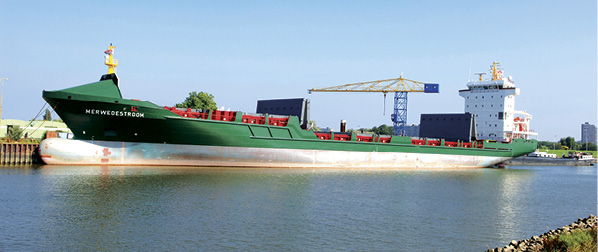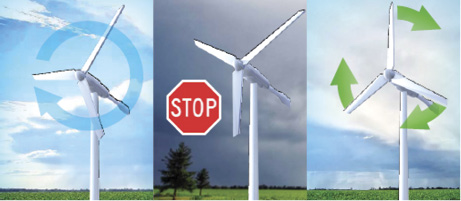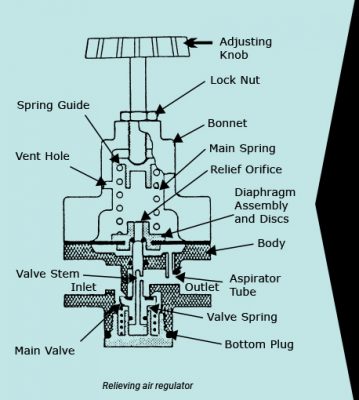Contributing to the Future of Wind Power Generation
By Andy Smith, Product Group Manager and Daniel Bate, Renewables Sales Manager Trelleborg Offshore
We are witnessing the most exciting period for the renewables industry in real time. As the worldwide demand for renewable energy is growing, companies are independently supporting and driving the innovation of competitive clean power. With many countries across the globe setting goals for renewable energy supply targets, and the completion of the first offshore wind project in the United States, the future of wind power generation is looking bright.
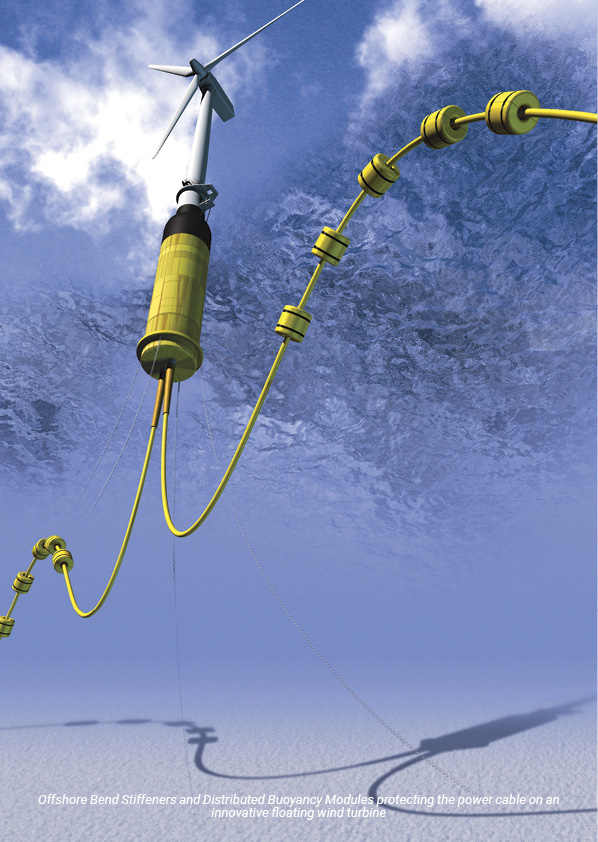
Floating vs Fixed
So far, the rapid growth in the offshore wind market has been achieved near land, using fixed platforms. These platforms typically use monopile or jacket structures to secure turbines to the seabed. Similar growth is anticipated in offshore floating structures, where turbines are installed on steel or concrete floating foundations, which are moored to the ocean floor. Fixed or floating, these custom-built platforms are specifically designed for the location where they will generate power for the lifetime of the wind farm, but how do they differ?
The most significant difference between the two structures is the depth at which they can operate. For fixed platforms, their technical and economic viability reduces with increasing water depth, limiting their use to sand banks and coastal waters, up to approximately 50 meters deep. On the other hand, floating platforms can be placed in deeper waters, allowing them to tap into the richer and vast wind resources further offshore. These designs are only subjected to the constraints of long cable tiebacks to the shore. Various countries across Europe and Asia, as well as the U.S., are actively pursuing the development of floating wind technology in order to substantially increase their wind power generation capacity. Locating future wind farm projects further offshore can also help address the aesthetic challenges whilst better accommodating fishing areas and shipping lanes.
For both fixed and floating wind, the uptake and development of technologies to drive the energy efficiencies, commercial viability, and growth is rapid and exciting. Trelleborg’s offshore operation has focused on applying its experience and expertise in providing solutions to overcome critical challenges and contribute to this continued growth—particularly with power cable reliability for life of field, and radar interference of offshore wind farms
Critical Cable Protection
In both fixed and floating platform arrangements, the energy generated by the turbines is sent onshore via high voltage subsea power cables. However, these cables are subjected to a variety of motions and loads during their installation and operational lifetime. Due to their location, cable failures or faults can be very costly and severely impact the performance and revenue of a wind farm.
Enhancing Fatigue Protection for Fixed Wind Cables
For fixed wind farms, power cables are used to connect the fixed turbines together into an array, which transfers the energy generated back to a substation (i.e., electrical hub of the wind farm) and then to the shore.
The entry and exit point of the power cable at each turbine and substation is of particular importance as waves and tidal currents will induce motions and loads to the cable throughout the life of the field. These effects can cause significant cable fatigue and damage; therefore, protection is required from each entry and exit point to the burial point. In some cases, the burial point can be 20 to 30 meters from the turbine base with a significant free span. Trelleborg’s experience in dynamic cable protection overcomes these issues using tried and tested design methodologies and materials, originally developed within the offshore oil and gas market.
One such solution is Trelleborg’s NjordGuard™. Both easy to assemble on the vessel and quick and reliable to install subsea, NjordGuard is a cable protection system specifically designed to protect the cable at these entry and exit points.
As an integrated protection system, designed for dynamic service, NjordGuard incorporates Trelleborg’s proven dynamic bend protection methodologies, to not only protect the cable from over-bending, during installation and extreme storm conditions, but crucially to also protect the cable from fatigue under sustained cyclic loading, which is generally the main cause of damage. As with oil and gas and floating wind dynamic bend stiffener products, the NjordGuard system incorporates homogeneous elastomeric cones with geometry and material properties designed to provide a gradual and tailored transition in stiffness from its tip to its base as the cable approaches the fixed entry point. As well as protecting the cable from over-bending, this gradual increase in stiffness is vital for fatigue protection as it provides continuous support under all load cases, in all directions for the cable, distributing the loads and preventing any sudden stress transitions. In addition to the inherent fatigue mitigation of Njordguard, Trelleborg has also integrated their abrasion and impact resistant product Uraduct® to ensure that the cable does not suffer damage around its burial point.
Protecting Dynamic Cable Configurations on Floating Platforms
In floating wind production environments, power cables are used to connect the floating turbines to the substation and the shore. As with fixed, the offshore environment is also dynamic in nature, placing an increased demand on the power cables. Securing, guiding, and protecting these power cables is therefore of utmost importance. In order to segregate motion near the surface from the deeper cable routing, the product portfolio must expand to incorporate buoyancy modules and bend restrictors alongside the dynamic bend stiffeners and abrasion and impact protection systems integrated on NjordGuard. Bend restrictors being a series of interlocking vertebrae molded from structural polymers and designed to lock out at a given radius, preventing the cable from over-bending.
The protection of cables connecting floating turbines to each other and to the seabed require additional assurance as they experience continuous loads and movement throughout their service life, resulting from the increased degrees of freedom introduced by the dynamic motion of the floating structure itself, in addition to the storm waves and tidal currents seen by the cables on fixed designs.
When modeling and analyzing the cables in this application, there are several established configuration options that can be considered to bring the motions and loads to within manageable levels. In more benign conditions, a free catenary of the cable from the floating turbine down to the seabed may be suitable. However, in increasingly dynamic conditions, as would be experienced toward the deeper end of the continental shelf and beyond, midwater suspension of the cable by means of controlled buoyancy may be necessary. These configurations include “Lazy Wave,” “Steep Wave,” “Lazy-S,” “Steep-S,” and “Pliant Wave” and have frequently been deployed in the operations offshore. Their selection is dependent on particular field conditions and layout.
Fundamentally, however, each configuration enables an increase in the cable length to improve its compliance relative to the dynamic movement of the floating structure, reducing loads and motions on it to within manageable levels. Means of providing this midwater suspension of the cable is by buoyancy modules specifically distributed at designated positions along the cable. These can be quickly installed onto the cable during the cable lay operation and they do not require mooring or anchoring to the seabed.
In each of the cable configurations, including free catenary, bringing the motions and loads translated into the cables to manageable levels, again, needs to consider suitable bend protection of the cable where it enters the floating structure and terminates on the seabed.
Bend protection devices, like bend restrictors and bend stiffeners, are designed to protect power cables from excessive loads and bending during installation and service.
Both devices:
- Maintain the cable manufacturer’s recommended Minimum Bend Radius (MBR) during the life of the project
- Provide suitable load distribution from flexible to fixed structures
- Reduce point loading at the termination to within an acceptable level
- However, the applicable circumstances for each product differs:
- For short-term installation and long-term static loads on the cable, such as on the seabed termination point, bend restrictors would be more applicable, as their interlocking vertebrae lock out at a given radius, protecting it at the maximum extent of bending. However, as it does not “stiffen” the cable, it offers little protection for the cumulative effect of dynamic motion.
- For dynamic applications where the cable is exposed to constant motion, such as on the entry of the cable into the floating turbine, then a bend stiffener is more applicable. As previously mentioned with regard to NjordGuard, a bend stiffener comprises of a homogeneous elastomeric cone, with geometry and material properties designed to provide a gradual and tailored transition in stiffness from its tip to its base, over the varied cable tensions and angles seen in dynamic motions. Many thousands of Trelleborg dynamic bend stiffeners have been supplied to projects across the globe for over 20 years without any in-service failures. The main drivers for this are the comprehensive design methodology, extensive material qualifications, and rigorous quality control processes during manufacturing.
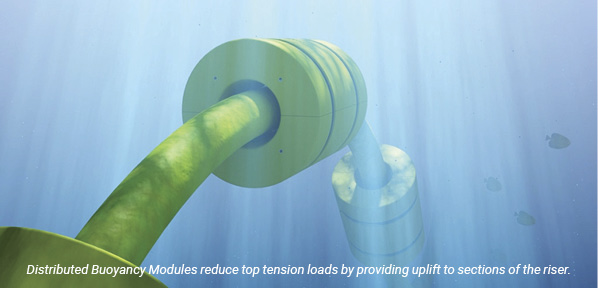
Radar Interference Mitigation Materials
Wind turbines used for wind farms, regardless of whether they are fixed or floating platforms, can cause interference with radar missions related to air traffic control and weather forecasting on modern radar systems. This interference causes complications that include aircraft ghosting, sometimes called shadowing, false tracking plots, clutter, false storm warnings, as well as hindering meteorological measurements.
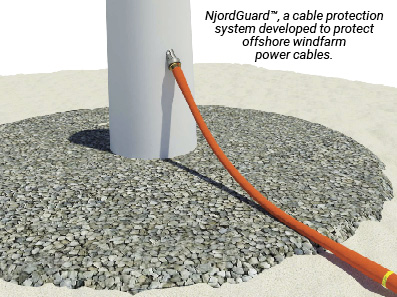 In many instances, wind turbine sites are refused planning permission in prime locations, which can cost millions in delays. In other cases, wind farm sites must scale back their plans and build fewer turbines (thus becoming less economically viable), due to the impact on radar systems. To maintain critical radar missions and accommodate future wind energy development opportunities, forward looking companies like Trelleborg are working to develop new coating technologies to mitigate wind turbine radar interference.
In many instances, wind turbine sites are refused planning permission in prime locations, which can cost millions in delays. In other cases, wind farm sites must scale back their plans and build fewer turbines (thus becoming less economically viable), due to the impact on radar systems. To maintain critical radar missions and accommodate future wind energy development opportunities, forward looking companies like Trelleborg are working to develop new coating technologies to mitigate wind turbine radar interference.
Conclusion
As the worldwide demand for renewable energy continues to grow, the future of wind power generation continues to evolve. What we envision today for this industry will change drastically over the next couple of years as countries push for clean power generation and visionaries think up innovative ways to meet global expectations.
Forward thinking companies like Trelleborg are willing to step up to the challenge and are excited to take part in the future developments of this industry.


